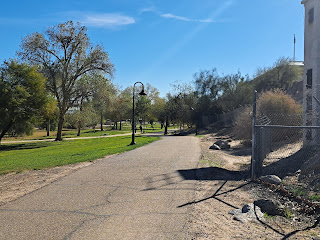Trails: Riverfront Trail, Nature Trail, et. al.
Hike Location: Colorado River State Historic Park and Yuma Territorial Prison State Historic Park
Geographic Location: downtown Yuma, AZ (32.72719, -114.62333)
Length: 2.9 miles
Difficulty: 1/10 (Easy)
Date Hiked: February 2024
Overview: An out-and-back connecting two historic sites in downtown Yuma.
Park Information, Army Depot: https://azstateparks.com/colorado-river
Hike Location: Colorado River State Historic Park and Yuma Territorial Prison State Historic Park
Geographic Location: downtown Yuma, AZ (32.72719, -114.62333)
Length: 2.9 miles
Difficulty: 1/10 (Easy)
Date Hiked: February 2024
Overview: An out-and-back connecting two historic sites in downtown Yuma.
Park Information, Army Depot: https://azstateparks.com/colorado-river
Park Information, Territorial Prison: https://azstateparks.com/yuma-territorial
Hike Route Map: https://www.mappedometer.com/?maproute=956431
Photo Highlight:
Start with a tour of the old army depot, which was active from 1865 until 1883. If you follow the self-guided tour's route, your first stop will be the old storehouse, a large building that looks like some old fieldhouses/gymnasiums I have seen in the Midwest. The building is filled with period items and many interpretive signs that describe life in Yuma in the late 1800's. Next comes the Office of the Depot Quartermaster, a smaller house-like building that contains some exhibits about military life. Stops at the officer's quarters and (much newer) corral house complete your tour.
To begin your journey to the Yuma Territorial Prison, walk back out through the Visitor Center, cross the parking lot, then turn right twice to begin heading east on an asphalt bike path with the Colorado River on your left and the old army depot you just toured on your right. The self-guided tour map calls this trail the Riverfront trail/Bike path, but it is unsigned on the ground. The asphalt trail winds through Gateway Park, a long narrow greenway along the Colorado River, as it passes first under the concrete I-10 bridge and then under the older but more aesthetically pleasing Ocean-to-Ocean Bridge. Nice views upstream along the river emerge even with all of the development.
1.25 miles into the hike (including the army depot walking tour), you reach the dirt trail that leads to the Yuma Territorial Prison. Turn right to leave the asphalt and begin a short but occasionally steep climb that winds around the prison cemetery and ends at the Yuma Territorial Prison's parking lot. Walk across the parking lot and through the admission building to enter the prison.
Like the old army depot, the old prison offers a self-guided walking tour. The tour starts with a viewpoint of the bridges you just walked under, but the first main point of interest is the old guard tower. Climbing the two flights of steps yields fantastic views across the desert to the east and over the prison to the southwest.
Next enter the prison itself by passing through the sally port and museum. This prison is every bit as foreboding as you would expect, especially the dark cell used for solitary confinement. This prison would be a truly miserable place to be in the hot desert summer. After touring the prison, walk back to the old army depot on the bike path to complete the hike. On your way back, be sure to take the short dirt Nature Trail that goes between the bike path and the river near the old prison. This trail passes through a pleasantly wooded area, and it lets you experience the riverside in a more natural setting compared to the rest of the hike.
Hike Route Map: https://www.mappedometer.com/?maproute=956431
Photo Highlight:
Hike Video: (coming April 11, 2025)
Directions to the trailhead: On the Arizona/California state line, take I-8 to 4th Avenue (California exit 172). Exit and go south on 4th Ave. Drive 4th Ave. south, and turn left to enter Colorado River State Historic Park immediately after crossing the Colorado River. This hike begins at Colorado River State Historic Park.
The hike: With a union entry date of February 14, 1912, Arizona is the youngest of the United States' contiguous 48 states. The northern three-fourths of Arizona's land was ceded to the United States by Mexico in 1848 at the end of the Mexican-American War, while the southern portion was acquired in 1853 via the Gadsden Purchase. The land was formally organized as the Arizona Territory in 1863, and those boundaries more or less correspond to the State of Arizona today.
Located in extreme southwest Arizona, the City of Yuma is one of the best places to go if you want a glimpse into Arizona's territorial days. The city is located at the old Yuma Crossing, which is one of the few naturally fordable points on the lower Colorado River. Two state historic parks are located in downtown Yuma: Colorado River State Historic Park, which protects an old army quartermaster depot, and Yuma Territorial Prison State Historic Park, which protects the old Arizona Territory prison. A bike trail goes along the Colorado River between the two parks, so you can see them both in one fairly easy hike, namely the one described here. Note that Arizona State Parks do not allow same-day use and do charge for pedestrian access, so you will need to pay park entrance fees at both parks.
 |
| Army depot storehouse |
 |
| Army depot officer's quarters |
 |
| Hiking the bike path |
 |
| Colorado River in downtown Yuma |
 |
| Hiking up to the prison |
 |
| View east from guard tower |
 |
| Prison cell block |





